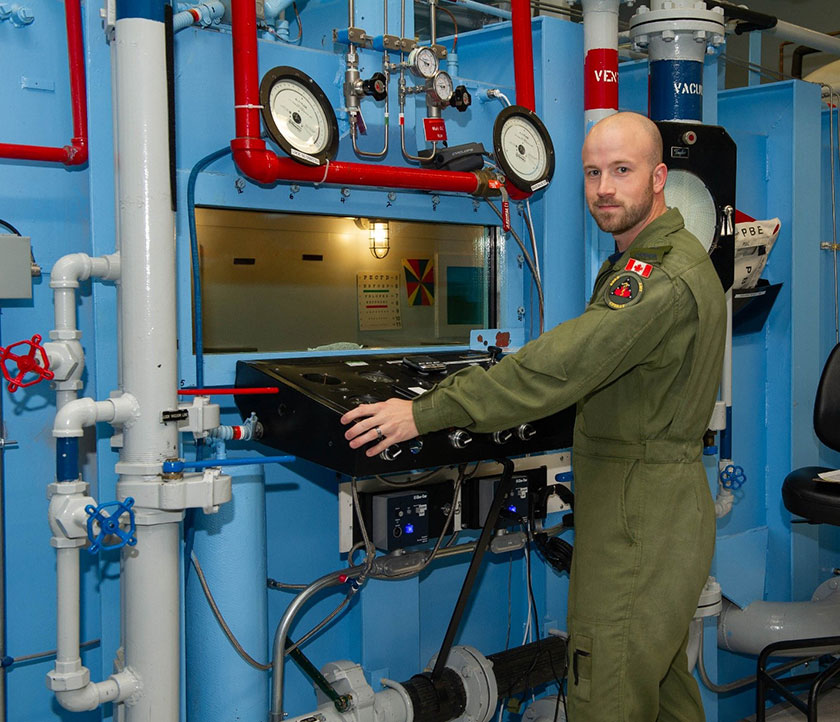A Wild Ride: Get to Know an Aviation Physiology Technician
October 7, 2022 - Defence Stories

Caption
Sgt Mohr completes operational checks on the Hypobaric Chamber prior to Hypoxia Recognition Training (HRT).
Cool is an understatement to describe Sergeant Myles Mohr’s occupation and experiences as an Aviation Physiology Technician.
Having joined the CAF in 2010 as a Medical Technician, Sergeant Mohr learned that he had a great interest in physiology. As an instructor previously, Sergeant Mohr had always gotten much satisfaction from the role. His passion for aviation physiology, coupled with his love for instructing united when he was able to teach in the field of aviation physiology.
The Aviation Physiology Technician occupation is a small specialist trade of about two dozen professionals. Because of this, the group of people that Sergeant Mohr works with are a close, tight knit team who work together to get the job done. As an instructor and an Aviation Physiology Technician at the Canadian Forces School of Survival & Aeromedical Training (CFSSAT), Sergeant Mohr’s job is not only dynamic but also requires he be skilled in two major roles: instructing and performing as a technician.
Sergeant Mohr and his team of instructors teach to audiences of CAF pilots and aircrew members. In their instructor role, Aviation Physiology Technicians teach Aeromedical Training courses, covering topics such as hypoxia (low oxygen levels), altitude decompression sickness, motion sickness, night vision, and spatial disorientation. Throughout this teaching, an emphasis is placed on the associated symptoms of the conditions. Students get to experience these symptoms firsthand in the simulators.
In their role as technicians, Aviation Physiology Technicians get an enormous amount of hands-on experience with the Aeromedical Training Simulators. It is the tech’s responsibility to do first line repairs on the equipment, as well as weekly maintenance to ensure everything is in good working condition and safe for use in the Aeromedical Training courses.
The simulator venues are quite impressive. Sergeant Mohr and his team work with simulation accessories such as a night vision room, hypobaric chamber, reduced oxygen-breathing device, virtual reality flight simulator, Barany chair, and spatial disorientation trainer. Using these simulators, Aeromedical Training students feel the diverse and intense symptoms associated with aviation physiology. This way, they know what to expect in actual scenarios. Notably, students acquire simulator experience, the effects of flying at high altitudes with low oxygen levels, as well as illusions associated with spatial disorientation.
Aviation Physiology Technicians are continuously learning. There are many opportunities for individuals in this occupation to expand their knowledge and pursue further training. Courses available to this occupation include Second Language Training, Land Survival, Arctic Survival, Conduct After Capture, and Survival Evasion Resistance and Escape (SERE) training. There are also opportunities for Aviation Physiology Technicians to be involved in High Altitude Airdrop Mission Support (HAAMS) with CANSOFCOM.
The Aviation Physiology Technician occupation is recruiting new members. If interested in obtaining additional information on this exciting occupation, please join our virtual information session on MS Teams on 03 November 2022, at 1200 hrs EDT. To receive the MS Teams link or for more information, please contact the Health Services Attraction team at: CFHSAttractionCell-CelluledattractionSSFC@forces.gc.ca.
Page details
- Date modified: